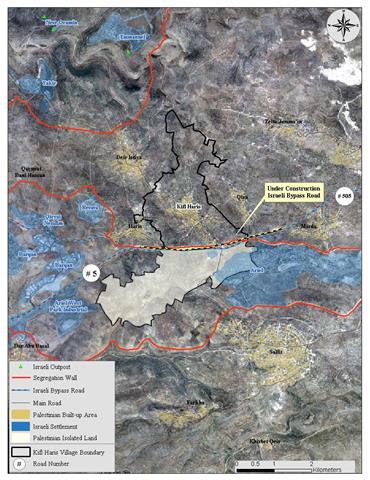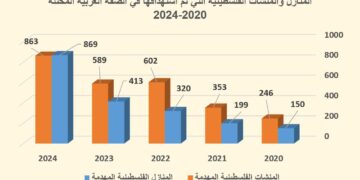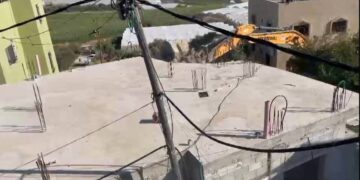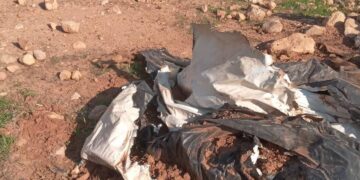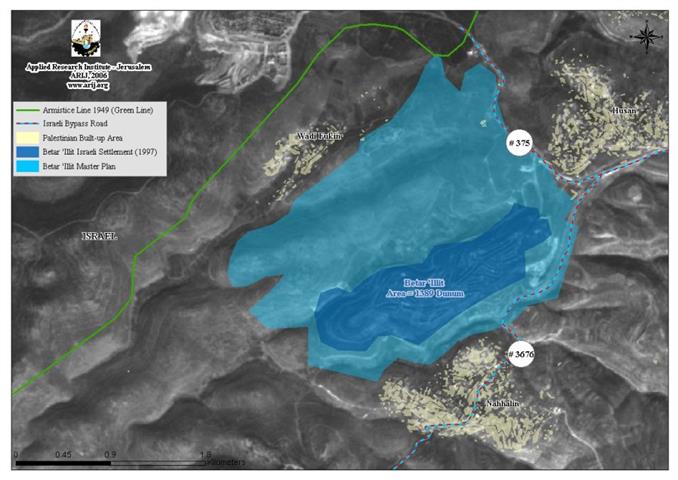On February 17, 2008, the Israeli Army bulldozers demolished a store for building-material that belong to the local resident from Kifil Haris; Mr. ‘Odeh Abdel Kader Shakkour, claiming that the store was located within the security buffer zone designated for the Israeli bypass road # 505; also known as 'Trans- Samaria Highway.' The bypass road in question 'Trans-Samaria' was originated back in 1992 starting from Kufur Qasim village inside the Green Line to the village of Marada in Salfit Governorate. It extends for a total length of approximately 20 kilometers and its width comes to 180 meters, which includes the actual road and the security buffer zone area where Palestinians are denied any right to use their land there. Consequently, the Israeli bypass road affected a total 8 Palestinian villages (Marada, Haris, Kifil Haris, Bidya, Burqin, Az-Zawya, Masha and Sarta) where thousands of trees were uprooted and thousands of dunums became out of commission.
For Kifil Haris, the Israeli bypass road # 505 had more determinate impact and damages that may very much affect the sustainability of the village’s residents. The facts on the ground shows that the bypass road had split the village in two sections, thus isolating 47% (4405 Dunums) of Kifil Haris total area, which stand at 9389 Dunums. More than that, the Israeli planned Segregation Wall set to engulf Ariel settlements bloc will consolidate this enforced reality when it isolated the 4405 Dunums within Ariel settlements bloc as well. Already 534 Dunums of the area isolated from Kifil Haris is confiscated by Ariel settlements, which sets southeast of Kifil Haris.
The construction work of the Israeli bypass road # 505 had finished in the year 2004, and with the Segregation Wall plan, Israel stands to inflict another nightmare of its enforced realities on the Palestinian people.
A New Security Road
Since the beginning of 2008, Israel started to construct a security road along the part-section of the existing 505- bypass road and the Segregation Wall that run on Kifil Haris land. Furthermore, and in compliance with the Israeli security road; Israel had closed a road that links Kifil Haris village with the nearby Haris village with earth mound (man-made dirt hill), and know the local residents of Kifil Haris have use an alternative 13 km root to reach their destination instead of the traditional 2 km root.
It is worth mentioning that the Israeli Occupation Forces had issued the military order that holds the number (105/05/T) with regard to the security road back in June 2005but as mentioned earlier, the actual construction did not commence until January 2008.
General Glance
Kifil Haris is one of the Palestinian villages of Salfit Governorate in the Northwestern part of the West Bank. It has a population of 3,233 (PCBS 2006). The village is located 4.5 kilometers away from the city of Salfit and 15 kilometers from Nablus city. It is bordered by Deir Istya village from its northwest side, the Illegal Israeli settlement of Ariel (est. 1978, populated by 16,500 settlers), the Segregation Wall, and the Israeli bypass road # 505 from its south and southeast sides. At the village’s west side there are Haris village and the Israeli Segregation Wall, and from its eastern side the village of Qira.
Kifil Haris spreads over an area of 9389 dunums of land, 435 of which constitute the Palestinian build up area. Following the irruption of the second Palestinian Intifada (Al Aqsa Intifada) in September 2000, Israel had imposed a military closure over the West Bank and prevented the Palestinians from entering Israel; which according to Israeli unilateral interpretation includes East Jerusalem, which dramatically affected on the economic situation of all of the Palestinian people there; especially those who used to work in Israel. Currently most of the local residents of the village are working in the Agriculture Sector, which constitutes the main and for many the only source of income. See Map of Kifl Haris
To Conclude
During the past four decades of the Israeli continued occupation of the Palestinian territory, Israel has resorted to several and various types of different pretexts to secure the existence of the Jewish settlements inside the Occupied Palestinian Territory, and during which time; Israel has continuing its violation of all signed agreements and International law rules and conventions, starting with building the Illegal bypass roads and settlements to the Segregation Wall. The Oslo Accord (The interim agreement of 1995), article1, item 2 and 4 clearly state (… the unity and integrity of the Palestinian people in the West Bank and Gaza Strip shall be maintained and respected…). The Israeli unilaterally planned and under construction network of ''bypass roads'' has contributed to further disrupt the life of the Palestinian people, and break-up the territorial contiguity of the occupied territory; thus disconnecting Palestinian communities from each other.
Article XXXI, Oslo II, 1995 also provides: Israelis forbidden from building or planning to any project or settlements or any colonial expansion or any plan that lead to change the status of the West Bank and Gaza Strip. The article provides “Neither side shall initiate or take any step that will change the status of the West Bank and the Gaza Strip pending the outcome of the permanent status negotiations”.
Article 147 of the Fourth Geneva Convention indicated that: 'Extensive destruction and appropriation of property not justified by military necessity and carried out unlawfully and wantonly, is a grave breach of the Convention'.
Article 53 of the same convention provides that 'any destruction by the Occupying power of real or personal property belonging individually or collectively to private persons, or to the State, or other public authorities or social or cooperative organizations is prohibited, except where such destruction is rendered absolutely necessary by military operations.'
In addition, Article 23 of The Hague Convention provides that: 'it forbidden to destroy or seize the enemy's property, 'unless such destruction or seizure is imperatively demanded by the necessities of war'.
Prepared by
The Applied Research Institute – Jerusalem


